Leading Change: Impact of Change on M&S Organisational Strategy
VerifiedAdded on 2020/07/22
|12
|3490
|40
Report
AI Summary
This report provides a comprehensive analysis of leading change within an organisation, specifically using Marks & Spencer (M&S) as a case study. It begins by examining the impact of change on organisational strategy and operations, differentiating between planned and unplanned changes, both internal and external. The report then explores the impact of internal and external drivers of change on leadership, team, and individual behavior, highlighting factors such as organizational culture, technological advancements, political, economic, social, and technological drivers. Furthermore, it discusses measures to minimize the negative impact of change, including the application of the Burke-Litwin model and the continuous improvement model. The report concludes with an application of the Hersey Blanchard Situational Leadership model in relation to change at M&S, offering insights into how the company can effectively navigate change and maintain a competitive edge. The report emphasizes the importance of adapting strategies to changing market dynamics and competitor actions to achieve organizational goals such as increased sales, competitive advantage, and greater market share. Finally, it provides a comparison of different organizations in terms of changing strategies and policies.

Understanding
and
Leading change
and
Leading change
Paraphrase This Document
Need a fresh take? Get an instant paraphrase of this document with our AI Paraphraser
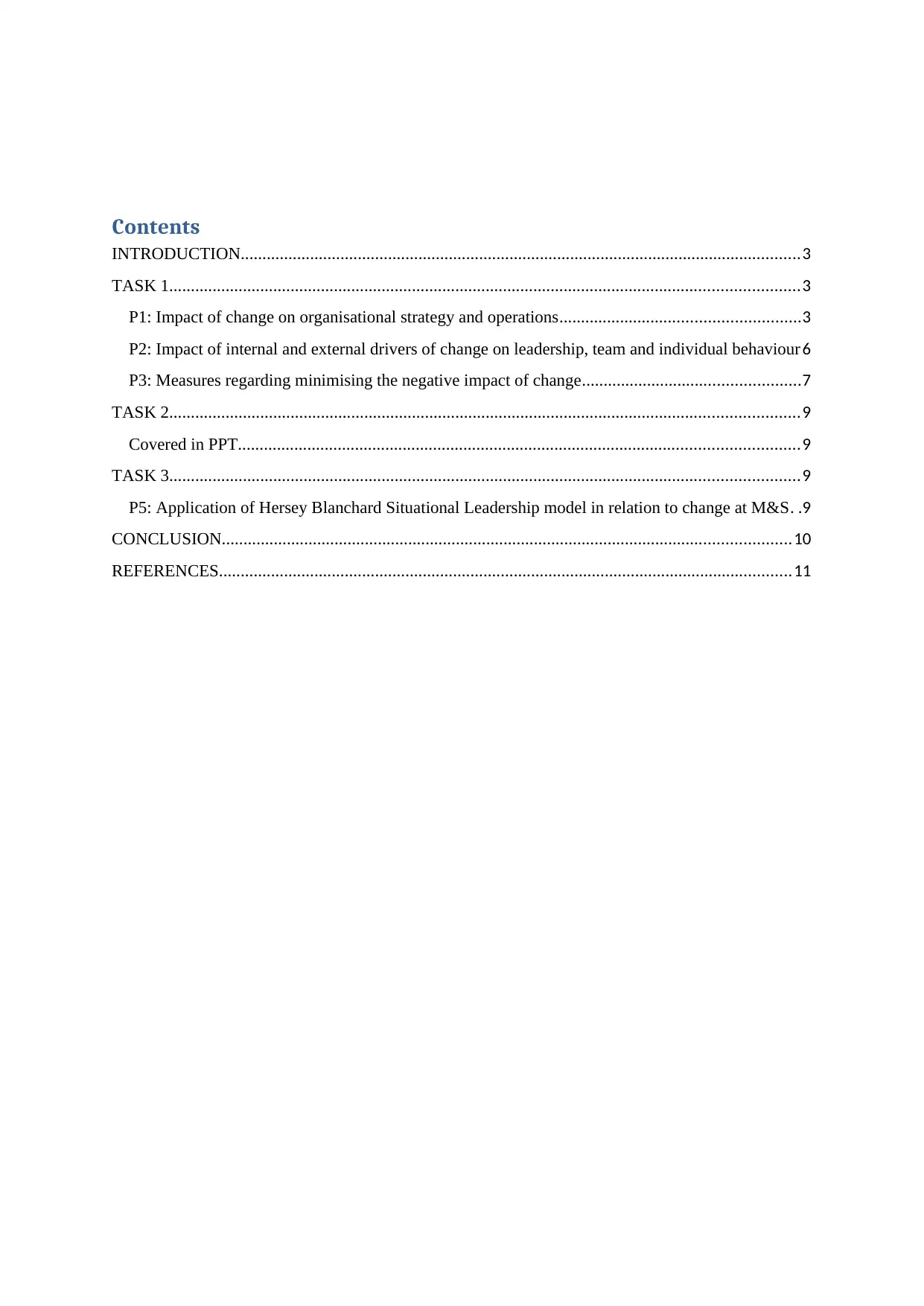
Contents
INTRODUCTION.................................................................................................................................3
TASK 1.................................................................................................................................................3
P1: Impact of change on organisational strategy and operations.......................................................3
P2: Impact of internal and external drivers of change on leadership, team and individual behaviour 6
P3: Measures regarding minimising the negative impact of change..................................................7
TASK 2.................................................................................................................................................9
Covered in PPT.................................................................................................................................9
TASK 3.................................................................................................................................................9
P5: Application of Hersey Blanchard Situational Leadership model in relation to change at M&S. .9
CONCLUSION...................................................................................................................................10
REFERENCES....................................................................................................................................11
INTRODUCTION.................................................................................................................................3
TASK 1.................................................................................................................................................3
P1: Impact of change on organisational strategy and operations.......................................................3
P2: Impact of internal and external drivers of change on leadership, team and individual behaviour 6
P3: Measures regarding minimising the negative impact of change..................................................7
TASK 2.................................................................................................................................................9
Covered in PPT.................................................................................................................................9
TASK 3.................................................................................................................................................9
P5: Application of Hersey Blanchard Situational Leadership model in relation to change at M&S. .9
CONCLUSION...................................................................................................................................10
REFERENCES....................................................................................................................................11
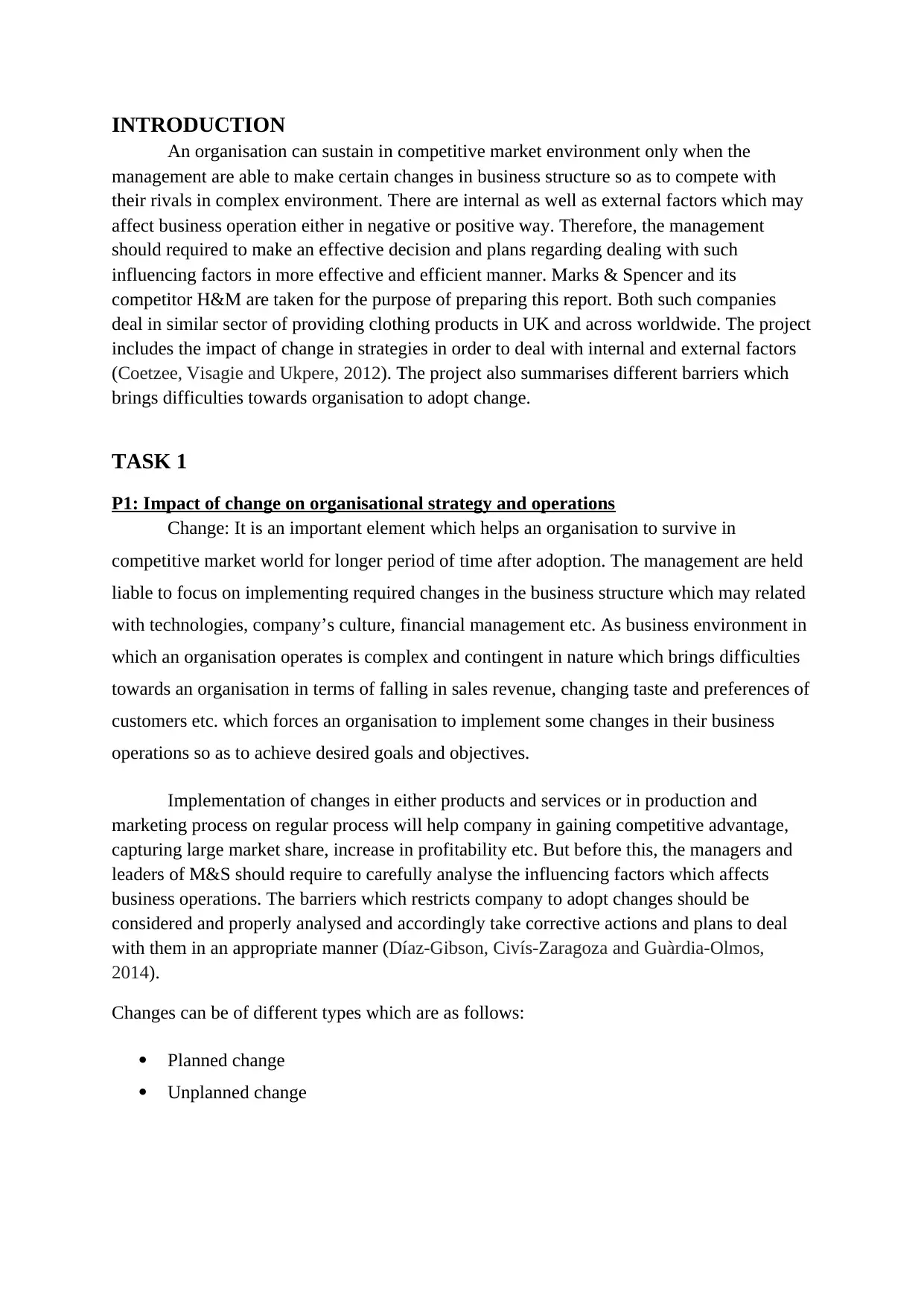
INTRODUCTION
An organisation can sustain in competitive market environment only when the
management are able to make certain changes in business structure so as to compete with
their rivals in complex environment. There are internal as well as external factors which may
affect business operation either in negative or positive way. Therefore, the management
should required to make an effective decision and plans regarding dealing with such
influencing factors in more effective and efficient manner. Marks & Spencer and its
competitor H&M are taken for the purpose of preparing this report. Both such companies
deal in similar sector of providing clothing products in UK and across worldwide. The project
includes the impact of change in strategies in order to deal with internal and external factors
(Coetzee, Visagie and Ukpere, 2012). The project also summarises different barriers which
brings difficulties towards organisation to adopt change.
TASK 1
P1: Impact of change on organisational strategy and operations
Change: It is an important element which helps an organisation to survive in
competitive market world for longer period of time after adoption. The management are held
liable to focus on implementing required changes in the business structure which may related
with technologies, company’s culture, financial management etc. As business environment in
which an organisation operates is complex and contingent in nature which brings difficulties
towards an organisation in terms of falling in sales revenue, changing taste and preferences of
customers etc. which forces an organisation to implement some changes in their business
operations so as to achieve desired goals and objectives.
Implementation of changes in either products and services or in production and
marketing process on regular process will help company in gaining competitive advantage,
capturing large market share, increase in profitability etc. But before this, the managers and
leaders of M&S should require to carefully analyse the influencing factors which affects
business operations. The barriers which restricts company to adopt changes should be
considered and properly analysed and accordingly take corrective actions and plans to deal
with them in an appropriate manner (Díaz-Gibson, Civís-Zaragoza and Guàrdia-Olmos,
2014).
Changes can be of different types which are as follows:
Planned change
Unplanned change
An organisation can sustain in competitive market environment only when the
management are able to make certain changes in business structure so as to compete with
their rivals in complex environment. There are internal as well as external factors which may
affect business operation either in negative or positive way. Therefore, the management
should required to make an effective decision and plans regarding dealing with such
influencing factors in more effective and efficient manner. Marks & Spencer and its
competitor H&M are taken for the purpose of preparing this report. Both such companies
deal in similar sector of providing clothing products in UK and across worldwide. The project
includes the impact of change in strategies in order to deal with internal and external factors
(Coetzee, Visagie and Ukpere, 2012). The project also summarises different barriers which
brings difficulties towards organisation to adopt change.
TASK 1
P1: Impact of change on organisational strategy and operations
Change: It is an important element which helps an organisation to survive in
competitive market world for longer period of time after adoption. The management are held
liable to focus on implementing required changes in the business structure which may related
with technologies, company’s culture, financial management etc. As business environment in
which an organisation operates is complex and contingent in nature which brings difficulties
towards an organisation in terms of falling in sales revenue, changing taste and preferences of
customers etc. which forces an organisation to implement some changes in their business
operations so as to achieve desired goals and objectives.
Implementation of changes in either products and services or in production and
marketing process on regular process will help company in gaining competitive advantage,
capturing large market share, increase in profitability etc. But before this, the managers and
leaders of M&S should require to carefully analyse the influencing factors which affects
business operations. The barriers which restricts company to adopt changes should be
considered and properly analysed and accordingly take corrective actions and plans to deal
with them in an appropriate manner (Díaz-Gibson, Civís-Zaragoza and Guàrdia-Olmos,
2014).
Changes can be of different types which are as follows:
Planned change
Unplanned change
⊘ This is a preview!⊘
Do you want full access?
Subscribe today to unlock all pages.

Trusted by 1+ million students worldwide

Planned change: It refers to such changes which are pre-planned by an organisation with a
motive of increasing effectiveness and health of an organisation. It can be divided into two
types which are as follows:
Planned internal change: Such change is related with organisational strategy which
needs to be implemented with a motive of changing nature of the business and the methods or
techniques of operating business functions. Such changes include:
Changes in the existing products and services: The management of M&S if observed
that demands of existing products and services falls due to changing taste and preferences
then it is required to adopt suitable change in their product through adding extra value to the
products so as to attract lots of customers.
Changing administrative systems: Such change should require to be implemented by
management of M&S in order to improve brand of company and gaining competitive
advantage of being a political power within an organisation. Changing in business structure,
communication hierarchy etc. includes in such change (Doğru, 2015).
Planned external change: There are internal as well as external factors which drives
an organisation to adopt changes. Various factors such as technological advancement,
innovation and improvement in communication channels. Such factors are external in nature
but are developed in company in a planned manner. Such changes include:
Technological innovation: Upgrading existing technologies used in production and
marketing process will help M&S to achieving profitable outcomes in near future. For
example, upgrading old technology with new and advanced technology in production process
will help in reducing cost of production through minimising wastage through which M&S are
able to provide products and services at affordable prices.
Advancement in communication and information processing: Information process
technologies such as wireless technology, satellite communication technology, networking
etc brings easiness for M&S to contact with the customers and business partners.
Unplanned internal change: It refers to such changes which takes place in an
organisation in unplanned manner. Such changes include:
Change in demographic composition: Increasing in the number of women workforce
in an organisation or leaving old employees after completing tenure results of globalisation of
motive of increasing effectiveness and health of an organisation. It can be divided into two
types which are as follows:
Planned internal change: Such change is related with organisational strategy which
needs to be implemented with a motive of changing nature of the business and the methods or
techniques of operating business functions. Such changes include:
Changes in the existing products and services: The management of M&S if observed
that demands of existing products and services falls due to changing taste and preferences
then it is required to adopt suitable change in their product through adding extra value to the
products so as to attract lots of customers.
Changing administrative systems: Such change should require to be implemented by
management of M&S in order to improve brand of company and gaining competitive
advantage of being a political power within an organisation. Changing in business structure,
communication hierarchy etc. includes in such change (Doğru, 2015).
Planned external change: There are internal as well as external factors which drives
an organisation to adopt changes. Various factors such as technological advancement,
innovation and improvement in communication channels. Such factors are external in nature
but are developed in company in a planned manner. Such changes include:
Technological innovation: Upgrading existing technologies used in production and
marketing process will help M&S to achieving profitable outcomes in near future. For
example, upgrading old technology with new and advanced technology in production process
will help in reducing cost of production through minimising wastage through which M&S are
able to provide products and services at affordable prices.
Advancement in communication and information processing: Information process
technologies such as wireless technology, satellite communication technology, networking
etc brings easiness for M&S to contact with the customers and business partners.
Unplanned internal change: It refers to such changes which takes place in an
organisation in unplanned manner. Such changes include:
Change in demographic composition: Increasing in the number of women workforce
in an organisation or leaving old employees after completing tenure results of globalisation of
Paraphrase This Document
Need a fresh take? Get an instant paraphrase of this document with our AI Paraphraser

worldwide economies. Such situation forces an organisation to make sudden changes in order
to attain huge workforce.
Performance gaps: After analysing the performance of organisation in relation with
decrease in sales due to unexpected reasons, decrease in profit margins etc. forces
management of M&S to make sudden changes in order to improve such gaps.
Unplanned external changes: It includes two factors such as economic uncertainties
and changes in government rules and regulations which drives an organisation to implement
change (Iles, 2017).
Government regulation: Changes in government regulation in relation with taxation
policy, regulation regarding de-licensing, currency conversion etc. drives organisation to
make changes in their terms and policies of operating business operations.
Global economic competition: It creates pressures on an organisation to change in
order to capture large market share and increase customer base through following various
promotional strategies and communication campaigns.
Changes can be made by M&S with an objective of achieving:
Increases in sales and revenue: The management of M&S should required to adopt
changes in business structure, existing products and services etc. with a motive of increasing
sales figure of clothing products and generate huge revenues. For example, improving
existing products through implementing value added changes will help in influencing interest
and buying behaviour of customers.
Competitive advantage: Changes made in terms of strategies and policies after
analysing competitor’s strategies will help M&S in gaining competitive advantages. They
also need to focus on changing clothing trends in market and accordingly produce demanded
products in order to maximises sales and compete with their rivals in more effective and
efficient manner.
More market share: M&S is multinational company which deals in providing
clothing products thus already capturing large market share. But to maintain their stable
position in market, the company should make regular changes in their products and services
in order to maximise the satisfaction level of customers.
Comparison of different organisation in terms of changing strategies and policies:
to attain huge workforce.
Performance gaps: After analysing the performance of organisation in relation with
decrease in sales due to unexpected reasons, decrease in profit margins etc. forces
management of M&S to make sudden changes in order to improve such gaps.
Unplanned external changes: It includes two factors such as economic uncertainties
and changes in government rules and regulations which drives an organisation to implement
change (Iles, 2017).
Government regulation: Changes in government regulation in relation with taxation
policy, regulation regarding de-licensing, currency conversion etc. drives organisation to
make changes in their terms and policies of operating business operations.
Global economic competition: It creates pressures on an organisation to change in
order to capture large market share and increase customer base through following various
promotional strategies and communication campaigns.
Changes can be made by M&S with an objective of achieving:
Increases in sales and revenue: The management of M&S should required to adopt
changes in business structure, existing products and services etc. with a motive of increasing
sales figure of clothing products and generate huge revenues. For example, improving
existing products through implementing value added changes will help in influencing interest
and buying behaviour of customers.
Competitive advantage: Changes made in terms of strategies and policies after
analysing competitor’s strategies will help M&S in gaining competitive advantages. They
also need to focus on changing clothing trends in market and accordingly produce demanded
products in order to maximises sales and compete with their rivals in more effective and
efficient manner.
More market share: M&S is multinational company which deals in providing
clothing products thus already capturing large market share. But to maintain their stable
position in market, the company should make regular changes in their products and services
in order to maximise the satisfaction level of customers.
Comparison of different organisation in terms of changing strategies and policies:

Strategies M&S
Marketing strategies It is multination company thus required to implement changes in
marketing strategies in order to grab attention of large number of
customers and influences their buying behaviour to purchase
their products. For example, hiring any celebrity to promote their
clothing product easily attracts maximum number of customers.
Pricing strategies It is important for an organisation to make changes in existing
pricing policies so that their clothing products can be afforded by
maximum number of people.
People Changes in communication channel will help employees to get
easily contact with the top authority and provide them issues and
problems faced by them at workplace. This will maximises the
satisfaction level of employees which makes positive impact on
their performance as well.
Process Changes in the process of different business activities help in
achieving profitable outcomes. For example, changes in
technologies used in production process will reduce cost of
production through minimising wastage and through which the
company are able to prove quality products at an affordable
prices.
P2: Impact of internal and external drivers of change on leadership, team and
individual behaviour
There are two major factors i.e. internal and external factors which affect business
operations either in negative or positive manner. Internal factors includes technologies,
employee’s behaviour etc. whereas external factors includes political, economical,
environmental etc. Such factors are briefly described as below:
Internal drives of change:
Organisation culture: There are large number of employees working in M&S which
comes from different cultures and backgrounds thus cause differences and conflicts among
between them (Low, 2018). This will bring negative outcome to company in future thus need
to be resolved by management of M&S as quickly as possible. It can resolves through
changing in communication channels with the help of which the employees can easily
Marketing strategies It is multination company thus required to implement changes in
marketing strategies in order to grab attention of large number of
customers and influences their buying behaviour to purchase
their products. For example, hiring any celebrity to promote their
clothing product easily attracts maximum number of customers.
Pricing strategies It is important for an organisation to make changes in existing
pricing policies so that their clothing products can be afforded by
maximum number of people.
People Changes in communication channel will help employees to get
easily contact with the top authority and provide them issues and
problems faced by them at workplace. This will maximises the
satisfaction level of employees which makes positive impact on
their performance as well.
Process Changes in the process of different business activities help in
achieving profitable outcomes. For example, changes in
technologies used in production process will reduce cost of
production through minimising wastage and through which the
company are able to prove quality products at an affordable
prices.
P2: Impact of internal and external drivers of change on leadership, team and
individual behaviour
There are two major factors i.e. internal and external factors which affect business
operations either in negative or positive manner. Internal factors includes technologies,
employee’s behaviour etc. whereas external factors includes political, economical,
environmental etc. Such factors are briefly described as below:
Internal drives of change:
Organisation culture: There are large number of employees working in M&S which
comes from different cultures and backgrounds thus cause differences and conflicts among
between them (Low, 2018). This will bring negative outcome to company in future thus need
to be resolved by management of M&S as quickly as possible. It can resolves through
changing in communication channels with the help of which the employees can easily
⊘ This is a preview!⊘
Do you want full access?
Subscribe today to unlock all pages.

Trusted by 1+ million students worldwide
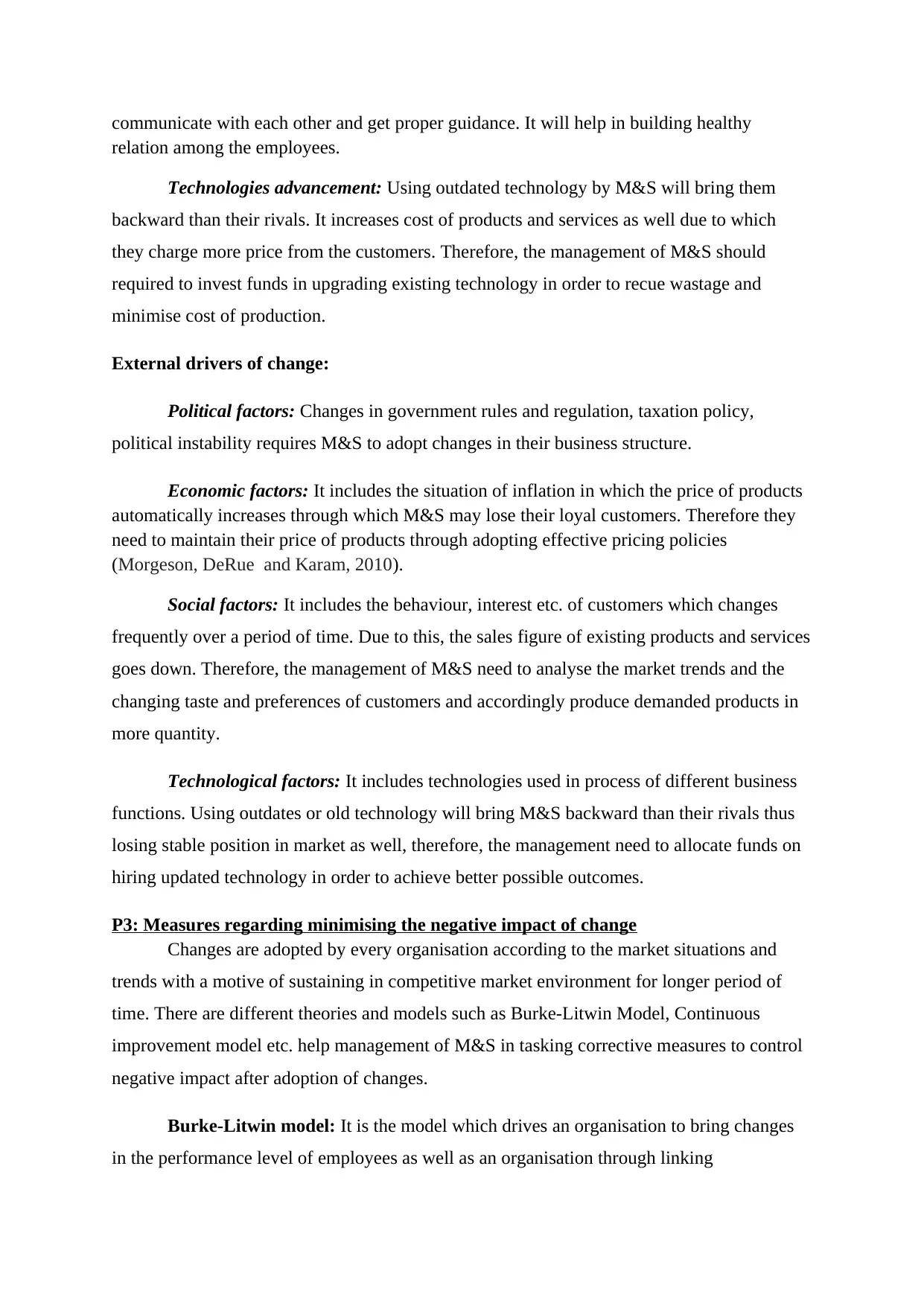
communicate with each other and get proper guidance. It will help in building healthy
relation among the employees.
Technologies advancement: Using outdated technology by M&S will bring them
backward than their rivals. It increases cost of products and services as well due to which
they charge more price from the customers. Therefore, the management of M&S should
required to invest funds in upgrading existing technology in order to recue wastage and
minimise cost of production.
External drivers of change:
Political factors: Changes in government rules and regulation, taxation policy,
political instability requires M&S to adopt changes in their business structure.
Economic factors: It includes the situation of inflation in which the price of products
automatically increases through which M&S may lose their loyal customers. Therefore they
need to maintain their price of products through adopting effective pricing policies
(Morgeson, DeRue and Karam, 2010).
Social factors: It includes the behaviour, interest etc. of customers which changes
frequently over a period of time. Due to this, the sales figure of existing products and services
goes down. Therefore, the management of M&S need to analyse the market trends and the
changing taste and preferences of customers and accordingly produce demanded products in
more quantity.
Technological factors: It includes technologies used in process of different business
functions. Using outdates or old technology will bring M&S backward than their rivals thus
losing stable position in market as well, therefore, the management need to allocate funds on
hiring updated technology in order to achieve better possible outcomes.
P3: Measures regarding minimising the negative impact of change
Changes are adopted by every organisation according to the market situations and
trends with a motive of sustaining in competitive market environment for longer period of
time. There are different theories and models such as Burke-Litwin Model, Continuous
improvement model etc. help management of M&S in tasking corrective measures to control
negative impact after adoption of changes.
Burke-Litwin model: It is the model which drives an organisation to bring changes
in the performance level of employees as well as an organisation through linking
relation among the employees.
Technologies advancement: Using outdated technology by M&S will bring them
backward than their rivals. It increases cost of products and services as well due to which
they charge more price from the customers. Therefore, the management of M&S should
required to invest funds in upgrading existing technology in order to recue wastage and
minimise cost of production.
External drivers of change:
Political factors: Changes in government rules and regulation, taxation policy,
political instability requires M&S to adopt changes in their business structure.
Economic factors: It includes the situation of inflation in which the price of products
automatically increases through which M&S may lose their loyal customers. Therefore they
need to maintain their price of products through adopting effective pricing policies
(Morgeson, DeRue and Karam, 2010).
Social factors: It includes the behaviour, interest etc. of customers which changes
frequently over a period of time. Due to this, the sales figure of existing products and services
goes down. Therefore, the management of M&S need to analyse the market trends and the
changing taste and preferences of customers and accordingly produce demanded products in
more quantity.
Technological factors: It includes technologies used in process of different business
functions. Using outdates or old technology will bring M&S backward than their rivals thus
losing stable position in market as well, therefore, the management need to allocate funds on
hiring updated technology in order to achieve better possible outcomes.
P3: Measures regarding minimising the negative impact of change
Changes are adopted by every organisation according to the market situations and
trends with a motive of sustaining in competitive market environment for longer period of
time. There are different theories and models such as Burke-Litwin Model, Continuous
improvement model etc. help management of M&S in tasking corrective measures to control
negative impact after adoption of changes.
Burke-Litwin model: It is the model which drives an organisation to bring changes
in the performance level of employees as well as an organisation through linking
Paraphrase This Document
Need a fresh take? Get an instant paraphrase of this document with our AI Paraphraser
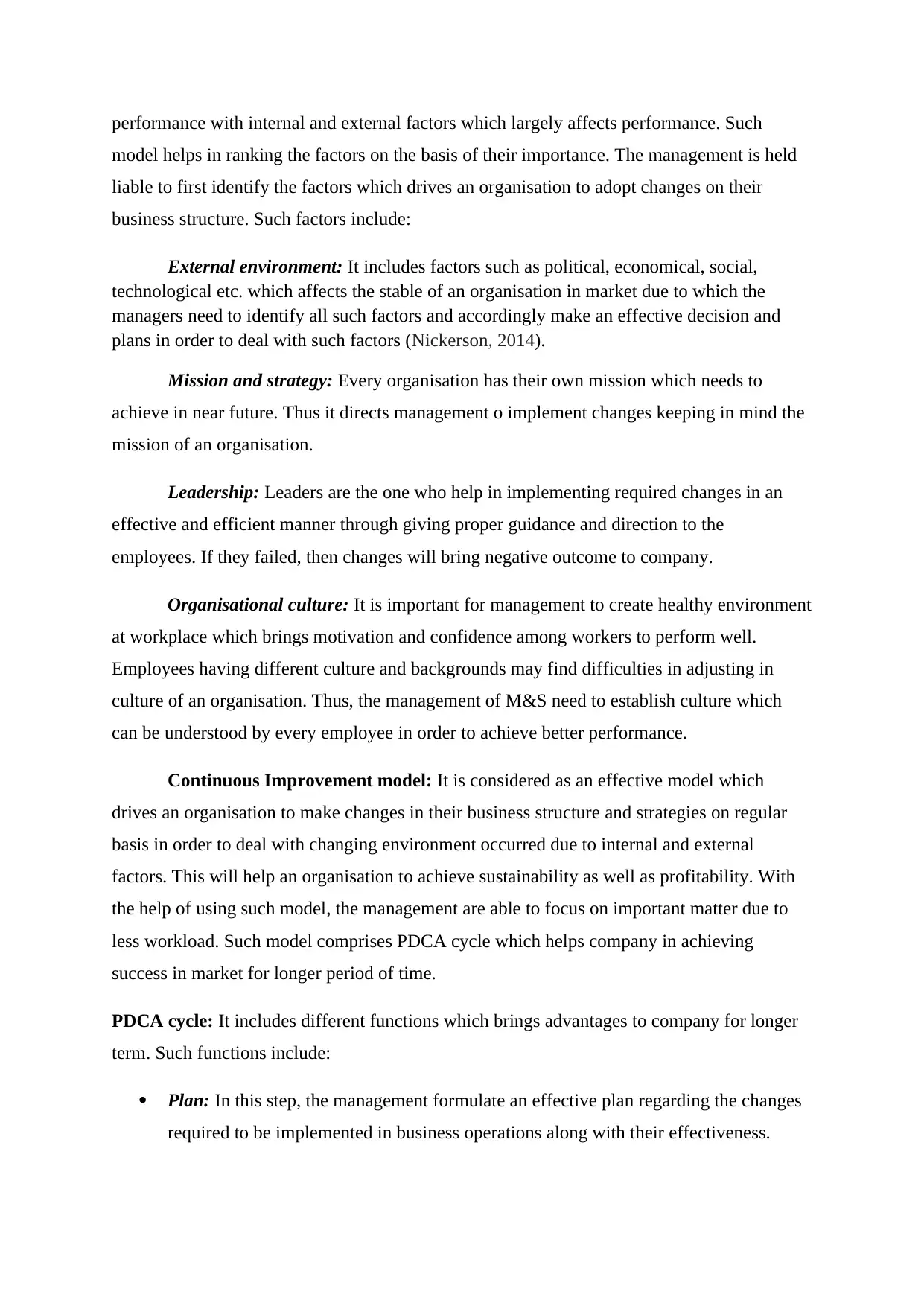
performance with internal and external factors which largely affects performance. Such
model helps in ranking the factors on the basis of their importance. The management is held
liable to first identify the factors which drives an organisation to adopt changes on their
business structure. Such factors include:
External environment: It includes factors such as political, economical, social,
technological etc. which affects the stable of an organisation in market due to which the
managers need to identify all such factors and accordingly make an effective decision and
plans in order to deal with such factors (Nickerson, 2014).
Mission and strategy: Every organisation has their own mission which needs to
achieve in near future. Thus it directs management o implement changes keeping in mind the
mission of an organisation.
Leadership: Leaders are the one who help in implementing required changes in an
effective and efficient manner through giving proper guidance and direction to the
employees. If they failed, then changes will bring negative outcome to company.
Organisational culture: It is important for management to create healthy environment
at workplace which brings motivation and confidence among workers to perform well.
Employees having different culture and backgrounds may find difficulties in adjusting in
culture of an organisation. Thus, the management of M&S need to establish culture which
can be understood by every employee in order to achieve better performance.
Continuous Improvement model: It is considered as an effective model which
drives an organisation to make changes in their business structure and strategies on regular
basis in order to deal with changing environment occurred due to internal and external
factors. This will help an organisation to achieve sustainability as well as profitability. With
the help of using such model, the management are able to focus on important matter due to
less workload. Such model comprises PDCA cycle which helps company in achieving
success in market for longer period of time.
PDCA cycle: It includes different functions which brings advantages to company for longer
term. Such functions include:
Plan: In this step, the management formulate an effective plan regarding the changes
required to be implemented in business operations along with their effectiveness.
model helps in ranking the factors on the basis of their importance. The management is held
liable to first identify the factors which drives an organisation to adopt changes on their
business structure. Such factors include:
External environment: It includes factors such as political, economical, social,
technological etc. which affects the stable of an organisation in market due to which the
managers need to identify all such factors and accordingly make an effective decision and
plans in order to deal with such factors (Nickerson, 2014).
Mission and strategy: Every organisation has their own mission which needs to
achieve in near future. Thus it directs management o implement changes keeping in mind the
mission of an organisation.
Leadership: Leaders are the one who help in implementing required changes in an
effective and efficient manner through giving proper guidance and direction to the
employees. If they failed, then changes will bring negative outcome to company.
Organisational culture: It is important for management to create healthy environment
at workplace which brings motivation and confidence among workers to perform well.
Employees having different culture and backgrounds may find difficulties in adjusting in
culture of an organisation. Thus, the management of M&S need to establish culture which
can be understood by every employee in order to achieve better performance.
Continuous Improvement model: It is considered as an effective model which
drives an organisation to make changes in their business structure and strategies on regular
basis in order to deal with changing environment occurred due to internal and external
factors. This will help an organisation to achieve sustainability as well as profitability. With
the help of using such model, the management are able to focus on important matter due to
less workload. Such model comprises PDCA cycle which helps company in achieving
success in market for longer period of time.
PDCA cycle: It includes different functions which brings advantages to company for longer
term. Such functions include:
Plan: In this step, the management formulate an effective plan regarding the changes
required to be implemented in business operations along with their effectiveness.
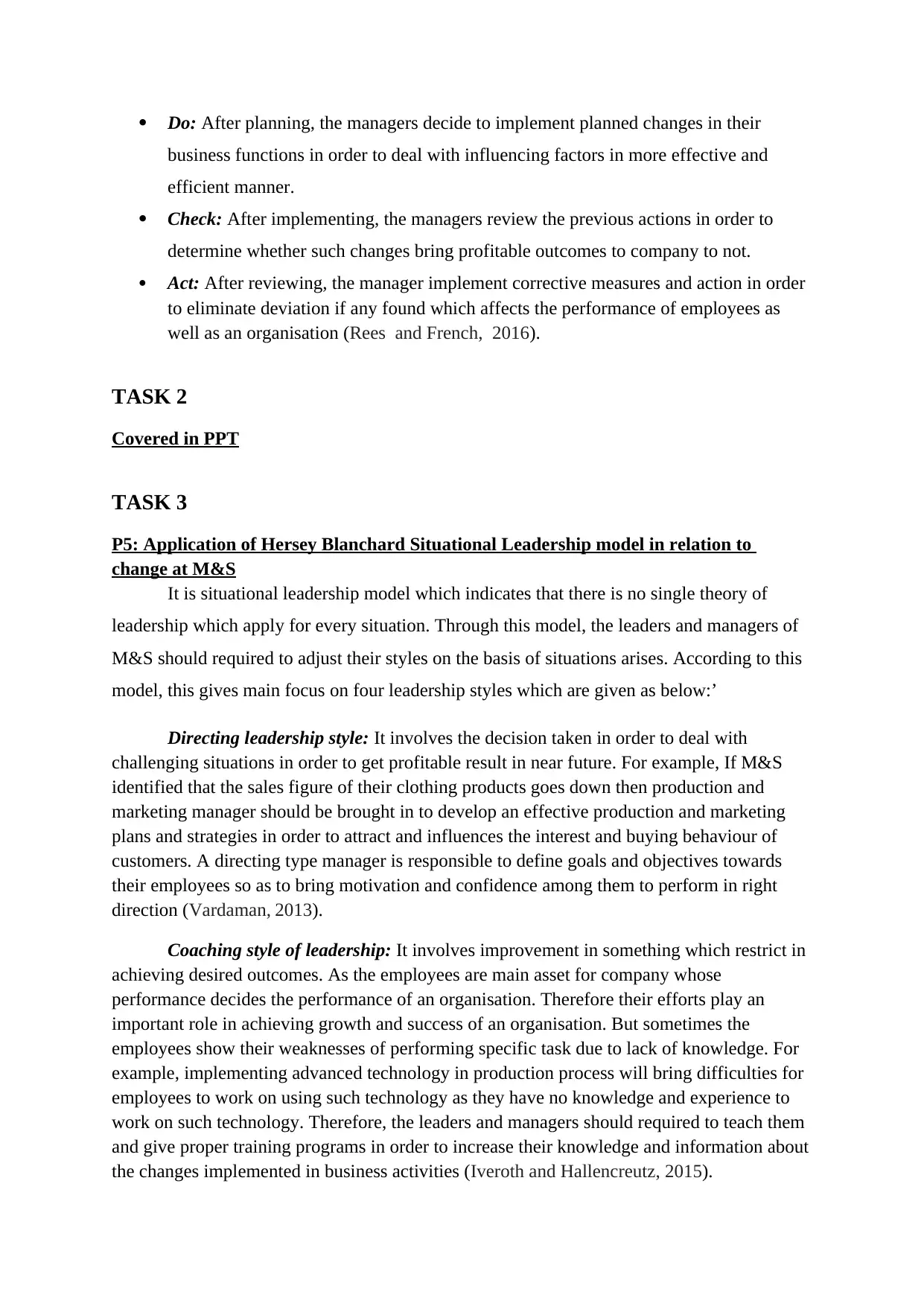
Do: After planning, the managers decide to implement planned changes in their
business functions in order to deal with influencing factors in more effective and
efficient manner.
Check: After implementing, the managers review the previous actions in order to
determine whether such changes bring profitable outcomes to company to not.
Act: After reviewing, the manager implement corrective measures and action in order
to eliminate deviation if any found which affects the performance of employees as
well as an organisation (Rees and French, 2016).
TASK 2
Covered in PPT
TASK 3
P5: Application of Hersey Blanchard Situational Leadership model in relation to
change at M&S
It is situational leadership model which indicates that there is no single theory of
leadership which apply for every situation. Through this model, the leaders and managers of
M&S should required to adjust their styles on the basis of situations arises. According to this
model, this gives main focus on four leadership styles which are given as below:’
Directing leadership style: It involves the decision taken in order to deal with
challenging situations in order to get profitable result in near future. For example, If M&S
identified that the sales figure of their clothing products goes down then production and
marketing manager should be brought in to develop an effective production and marketing
plans and strategies in order to attract and influences the interest and buying behaviour of
customers. A directing type manager is responsible to define goals and objectives towards
their employees so as to bring motivation and confidence among them to perform in right
direction (Vardaman, 2013).
Coaching style of leadership: It involves improvement in something which restrict in
achieving desired outcomes. As the employees are main asset for company whose
performance decides the performance of an organisation. Therefore their efforts play an
important role in achieving growth and success of an organisation. But sometimes the
employees show their weaknesses of performing specific task due to lack of knowledge. For
example, implementing advanced technology in production process will bring difficulties for
employees to work on using such technology as they have no knowledge and experience to
work on such technology. Therefore, the leaders and managers should required to teach them
and give proper training programs in order to increase their knowledge and information about
the changes implemented in business activities (Iveroth and Hallencreutz, 2015).
business functions in order to deal with influencing factors in more effective and
efficient manner.
Check: After implementing, the managers review the previous actions in order to
determine whether such changes bring profitable outcomes to company to not.
Act: After reviewing, the manager implement corrective measures and action in order
to eliminate deviation if any found which affects the performance of employees as
well as an organisation (Rees and French, 2016).
TASK 2
Covered in PPT
TASK 3
P5: Application of Hersey Blanchard Situational Leadership model in relation to
change at M&S
It is situational leadership model which indicates that there is no single theory of
leadership which apply for every situation. Through this model, the leaders and managers of
M&S should required to adjust their styles on the basis of situations arises. According to this
model, this gives main focus on four leadership styles which are given as below:’
Directing leadership style: It involves the decision taken in order to deal with
challenging situations in order to get profitable result in near future. For example, If M&S
identified that the sales figure of their clothing products goes down then production and
marketing manager should be brought in to develop an effective production and marketing
plans and strategies in order to attract and influences the interest and buying behaviour of
customers. A directing type manager is responsible to define goals and objectives towards
their employees so as to bring motivation and confidence among them to perform in right
direction (Vardaman, 2013).
Coaching style of leadership: It involves improvement in something which restrict in
achieving desired outcomes. As the employees are main asset for company whose
performance decides the performance of an organisation. Therefore their efforts play an
important role in achieving growth and success of an organisation. But sometimes the
employees show their weaknesses of performing specific task due to lack of knowledge. For
example, implementing advanced technology in production process will bring difficulties for
employees to work on using such technology as they have no knowledge and experience to
work on such technology. Therefore, the leaders and managers should required to teach them
and give proper training programs in order to increase their knowledge and information about
the changes implemented in business activities (Iveroth and Hallencreutz, 2015).
⊘ This is a preview!⊘
Do you want full access?
Subscribe today to unlock all pages.

Trusted by 1+ million students worldwide
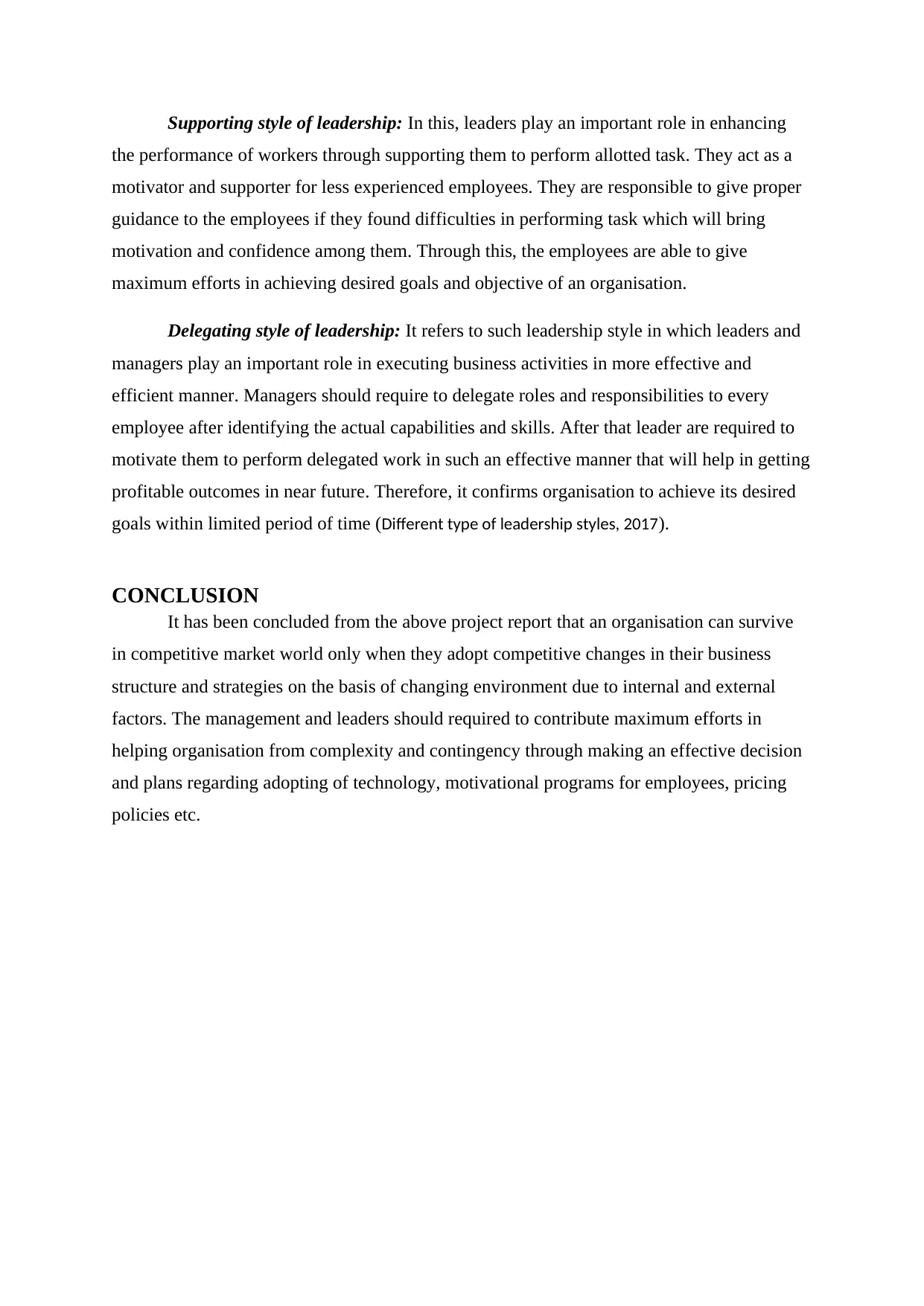
Supporting style of leadership: In this, leaders play an important role in enhancing
the performance of workers through supporting them to perform allotted task. They act as a
motivator and supporter for less experienced employees. They are responsible to give proper
guidance to the employees if they found difficulties in performing task which will bring
motivation and confidence among them. Through this, the employees are able to give
maximum efforts in achieving desired goals and objective of an organisation.
Delegating style of leadership: It refers to such leadership style in which leaders and
managers play an important role in executing business activities in more effective and
efficient manner. Managers should require to delegate roles and responsibilities to every
employee after identifying the actual capabilities and skills. After that leader are required to
motivate them to perform delegated work in such an effective manner that will help in getting
profitable outcomes in near future. Therefore, it confirms organisation to achieve its desired
goals within limited period of time (Different type of leadership styles, 2017).
CONCLUSION
It has been concluded from the above project report that an organisation can survive
in competitive market world only when they adopt competitive changes in their business
structure and strategies on the basis of changing environment due to internal and external
factors. The management and leaders should required to contribute maximum efforts in
helping organisation from complexity and contingency through making an effective decision
and plans regarding adopting of technology, motivational programs for employees, pricing
policies etc.
the performance of workers through supporting them to perform allotted task. They act as a
motivator and supporter for less experienced employees. They are responsible to give proper
guidance to the employees if they found difficulties in performing task which will bring
motivation and confidence among them. Through this, the employees are able to give
maximum efforts in achieving desired goals and objective of an organisation.
Delegating style of leadership: It refers to such leadership style in which leaders and
managers play an important role in executing business activities in more effective and
efficient manner. Managers should require to delegate roles and responsibilities to every
employee after identifying the actual capabilities and skills. After that leader are required to
motivate them to perform delegated work in such an effective manner that will help in getting
profitable outcomes in near future. Therefore, it confirms organisation to achieve its desired
goals within limited period of time (Different type of leadership styles, 2017).
CONCLUSION
It has been concluded from the above project report that an organisation can survive
in competitive market world only when they adopt competitive changes in their business
structure and strategies on the basis of changing environment due to internal and external
factors. The management and leaders should required to contribute maximum efforts in
helping organisation from complexity and contingency through making an effective decision
and plans regarding adopting of technology, motivational programs for employees, pricing
policies etc.
Paraphrase This Document
Need a fresh take? Get an instant paraphrase of this document with our AI Paraphraser
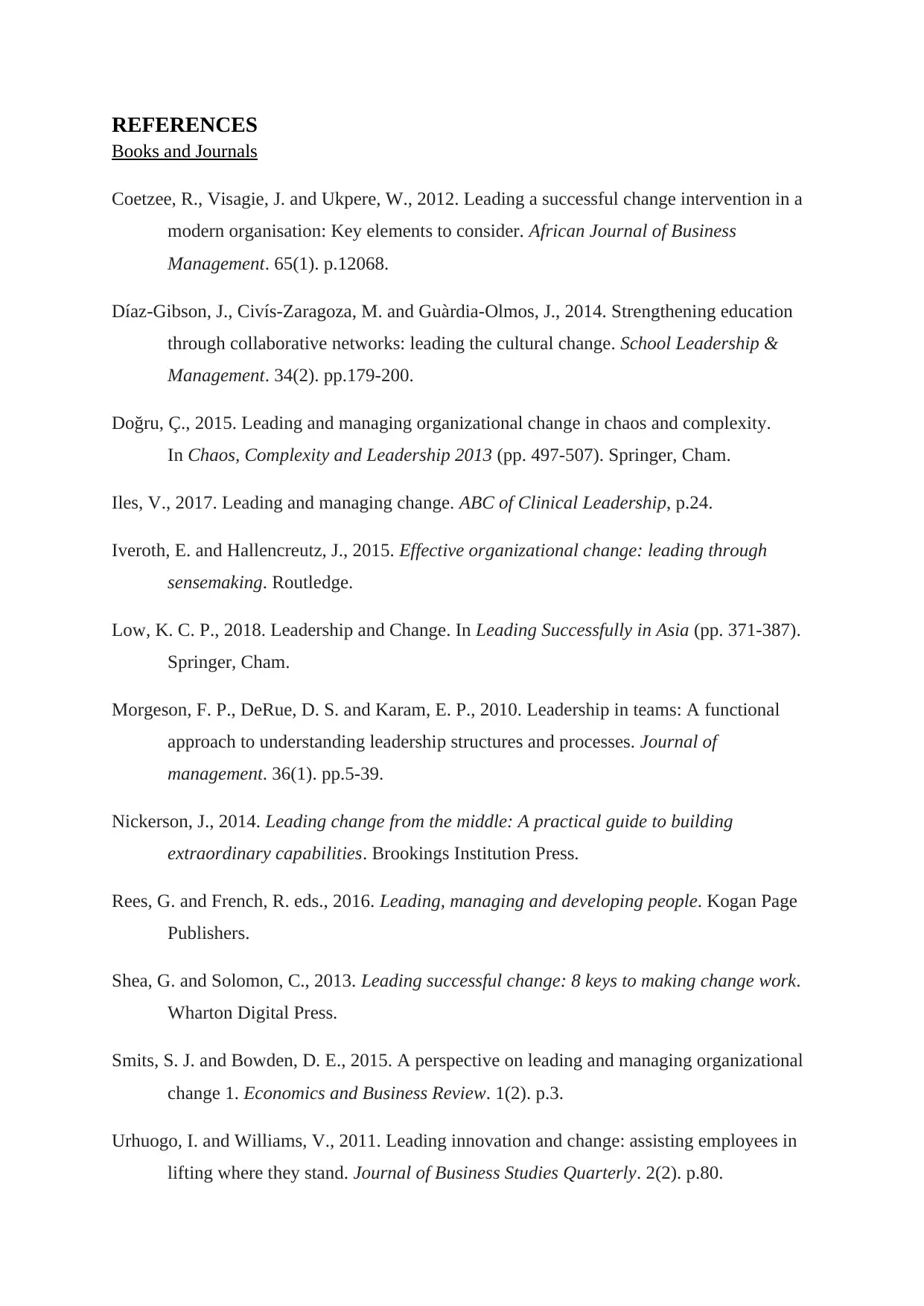
REFERENCES
Books and Journals
Coetzee, R., Visagie, J. and Ukpere, W., 2012. Leading a successful change intervention in a
modern organisation: Key elements to consider. African Journal of Business
Management. 65(1). p.12068.
Díaz-Gibson, J., Civís-Zaragoza, M. and Guàrdia-Olmos, J., 2014. Strengthening education
through collaborative networks: leading the cultural change. School Leadership &
Management. 34(2). pp.179-200.
Doğru, Ç., 2015. Leading and managing organizational change in chaos and complexity.
In Chaos, Complexity and Leadership 2013 (pp. 497-507). Springer, Cham.
Iles, V., 2017. Leading and managing change. ABC of Clinical Leadership, p.24.
Iveroth, E. and Hallencreutz, J., 2015. Effective organizational change: leading through
sensemaking. Routledge.
Low, K. C. P., 2018. Leadership and Change. In Leading Successfully in Asia (pp. 371-387).
Springer, Cham.
Morgeson, F. P., DeRue, D. S. and Karam, E. P., 2010. Leadership in teams: A functional
approach to understanding leadership structures and processes. Journal of
management. 36(1). pp.5-39.
Nickerson, J., 2014. Leading change from the middle: A practical guide to building
extraordinary capabilities. Brookings Institution Press.
Rees, G. and French, R. eds., 2016. Leading, managing and developing people. Kogan Page
Publishers.
Shea, G. and Solomon, C., 2013. Leading successful change: 8 keys to making change work.
Wharton Digital Press.
Smits, S. J. and Bowden, D. E., 2015. A perspective on leading and managing organizational
change 1. Economics and Business Review. 1(2). p.3.
Urhuogo, I. and Williams, V., 2011. Leading innovation and change: assisting employees in
lifting where they stand. Journal of Business Studies Quarterly. 2(2). p.80.
Books and Journals
Coetzee, R., Visagie, J. and Ukpere, W., 2012. Leading a successful change intervention in a
modern organisation: Key elements to consider. African Journal of Business
Management. 65(1). p.12068.
Díaz-Gibson, J., Civís-Zaragoza, M. and Guàrdia-Olmos, J., 2014. Strengthening education
through collaborative networks: leading the cultural change. School Leadership &
Management. 34(2). pp.179-200.
Doğru, Ç., 2015. Leading and managing organizational change in chaos and complexity.
In Chaos, Complexity and Leadership 2013 (pp. 497-507). Springer, Cham.
Iles, V., 2017. Leading and managing change. ABC of Clinical Leadership, p.24.
Iveroth, E. and Hallencreutz, J., 2015. Effective organizational change: leading through
sensemaking. Routledge.
Low, K. C. P., 2018. Leadership and Change. In Leading Successfully in Asia (pp. 371-387).
Springer, Cham.
Morgeson, F. P., DeRue, D. S. and Karam, E. P., 2010. Leadership in teams: A functional
approach to understanding leadership structures and processes. Journal of
management. 36(1). pp.5-39.
Nickerson, J., 2014. Leading change from the middle: A practical guide to building
extraordinary capabilities. Brookings Institution Press.
Rees, G. and French, R. eds., 2016. Leading, managing and developing people. Kogan Page
Publishers.
Shea, G. and Solomon, C., 2013. Leading successful change: 8 keys to making change work.
Wharton Digital Press.
Smits, S. J. and Bowden, D. E., 2015. A perspective on leading and managing organizational
change 1. Economics and Business Review. 1(2). p.3.
Urhuogo, I. and Williams, V., 2011. Leading innovation and change: assisting employees in
lifting where they stand. Journal of Business Studies Quarterly. 2(2). p.80.

Vardaman, D. L., 2013. Leading change: exploring the relationship between
transformational, transactional, and change-oriented leadership and their impact on
leadership effectiveness among pastors in a protestant denomination in the mid-
western United States. Indiana Wesleyan University.
Online
Different type of leadership styles, 2017. [Online] availavle
through<https://www.pinterest.com/pin/486670303463675723/>
transformational, transactional, and change-oriented leadership and their impact on
leadership effectiveness among pastors in a protestant denomination in the mid-
western United States. Indiana Wesleyan University.
Online
Different type of leadership styles, 2017. [Online] availavle
through<https://www.pinterest.com/pin/486670303463675723/>
⊘ This is a preview!⊘
Do you want full access?
Subscribe today to unlock all pages.

Trusted by 1+ million students worldwide
1 out of 12
Related Documents
Your All-in-One AI-Powered Toolkit for Academic Success.
+13062052269
info@desklib.com
Available 24*7 on WhatsApp / Email
![[object Object]](/_next/static/media/star-bottom.7253800d.svg)
Unlock your academic potential
Copyright © 2020–2025 A2Z Services. All Rights Reserved. Developed and managed by ZUCOL.





